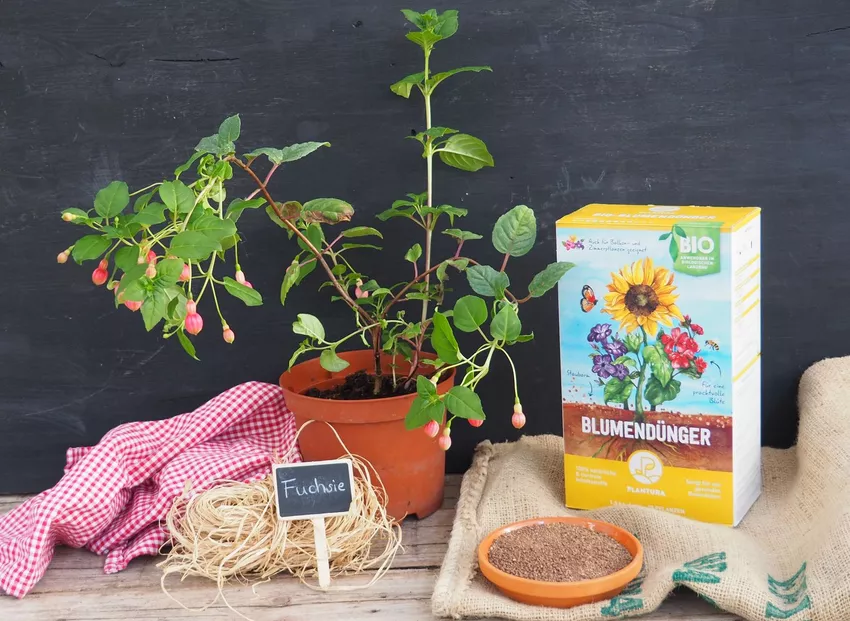The fuchsia owes its flowering power to proper care. We show how you can enjoy flowering fuchsias with the right care.

Fuchsias (Fuchsia) have long been valued in many gardens, but the exotic evening primrose plant (Onagraceae) originally comes from the mountain forests of South America. Because of this, it requires special care that is a little different from most other ornamental plants. We show how to optimally care for the fuchsia - from watering, to cutting, to overwintering.
Water and fertilize fuchsias properly
Especially when it comes to watering and fertilizing, some aspects should be considered so that the fuchsia stays he althy and has a lush and long flowering period. In the following we answer all questions on the topic.
Watering fuchsias: when and how much?
Fuchsias are among the plants that have an extremely high water requirement. In their natural environment, the tropical mountain forests, there is sufficient rainfall and the humidity is always high. Therefore, make sure that they find approximately similar conditions in your garden. Water fuchsias regularly so the root ball never dries out completely. Ideally, water every day as soon as the top layer of the substrate has dried again. In addition, the fuchsia is happy if you spray the leaves with water from time to time.

Fertilize fuchsias: with what and how much?
Basically, fuchsias need a larger amount of nutrients, especially for their flowering. The use of mineral fertilizers is often recommended for fuchsias, but it is not advisable for various reasons: On the one hand, even a slight overdose, especially in combination with little water, leads to burning of the sensitive roots. Furthermore, mineral fertilizers are the far less ecological option. For a resource-saving and soil-protecting handling, primarily organic means such as our Plantura organic flower fertilizer are includedLong-term effect preferable. In addition, especially in the first few months after repotting or planting, additional nutrient supply is counterproductive, since many commercially available soils are already pre-fertilized. Ideally, work slow-release fertilizer into the substrate several times a year. In particular, the high phosphate content promotes he althy flower growth in fuchsias.
When watering and fertilizing the fuchsia, be sure to consider the following aspects:
- Water regularly
- Spray leaves with water more often
- Mainly organic fertilization several times a year
Pruning fuchsias correctly
Professional pruning is sometimes crucial with the exotic fuchsia so that the blooms come again every year. Fuchsias always bloom on the new shoots of the year, so woody shoots lead to a decrease in the popular flowering in the long run. The optimal time for pruning the plant is usually autumn, just before the fuchsia starts overwintering. At this point, cut off the faded shoots, a third of the entire volume can easily be cut off. However, be careful when it comes to the woody areas inside the fuchsia. If possible, this should be spared from severe pruning.
Successfully wintering fuchsias
With their tropical to subtropical origin, fuchsias are not the right companions for problem-free wintering outdoors. For this reason, only very few varieties, mostly hybrids, are cultivated and overwintered outdoors. The majority still needs to be moved to a frost-free, dark and cool place during the winter. Ideally, the temperature there should be at least 2 °C and not more than 10 °C. In the fall, first carry out the annual cut on your fuchsia and then put it in a place to overwinter. From April, the potted plants can go outside again, but keep an eye out for late frosts until mid-May. Hardy breeds should always be covered with insulating material outdoors, such as brushwood, straw, leaves or garden fleece.

When overwintering your fuchsia, keep the following points in mind:
- Winter storage at 2 - 10 °C
- Cool, dark and dry location
- Perform an annual pruning in the fall
- Slowly outside again from April
More tips and tricksfor overwintering your fuchsia, as well as a number of particularly cold-resistant fuchsia varieties, can be found here in our special article.